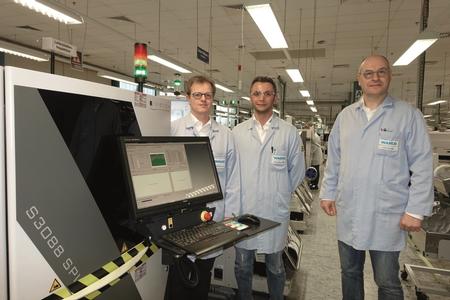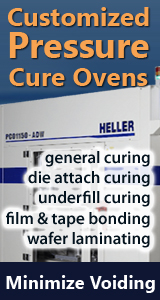WABCO has successfully optimized production quality on its prototyping line with the S3088 SPI and S3088 ultra from Viscom. Viscom Quality Uplink manages the data networking for WABCO, which is known for its ABS systems.
As part of an ongoing development partnership since 2014, WABCO has acquired a prototype line in stages at its Lindener Hafen location in Hanover, Germany. The line includes Viscom’s S3088 SPI and S3088 ultra. Today, the company’s false call rate has been consistently decreased and first pass yields (FPY) have significantly increased. "Electronic braking systems, transmission controls, air suspension systems and the associated peripherals, like compressors and air dryers – these are the electronic items our customers seek from us," states Lars Schulze, test methodologist at WABCO. Customers include DAF Trucks, Daimler, MAN, Scania and Volvo, as well as ZF Friedrichshafen. One very important product right now that is manufactured in the prototype line is a new, highly complex transmission electronic unit with around 450 components, to be used in utility vehicles as the core of the transmission control.
Among WABCO's goals for solder paste inspection (SPI) in the prototype line was the ability to entrust the employee occupied there with other tasks. This was very successfully realized with an S3088 SPI from Viscom. This system’s capabilities for automated data networking via the Quality Uplink and the verification station HARAN from Viscom were especially convincing.
Additionally, the S3088 SPI 3D function has been beneficial. Andreas Sommerfeld, process technician at WABCO explains: "If the paste is looked at from above, only a surface is seen. But I never know, is this paste volume also high enough and is it sufficient to definitively reach the minimum volume? This is better perceived with a 3D inspection than with a 2D." Viscom Quality Uplink also includes the Closed Loop between the solder paste inspection and the upstream stencil printer. Among its other functions, the SPI cyclically determines and transfers specific values to the printing process. "This way, the X/Y offset can be automatically corrected," says Sommerfeld. Consequently, he and his colleagues can greatly extend the printer cleaning cycle. This saves both time and material.
For the S3088 ultra, WABCO had stipulated a requirement for at least 80 percent FPY. Lars Schulze describes the advantages of automatic optical inspection (AOI) with 3D: "For the presence inspection, no special cameras or adapted illumination are needed; neither are fine adjustments for the different components or printed circuit board colors." With the 3D raster, whether or not the component is there is immediately apparent. "Now we have direct measurements, can record frequencies and statistically calculate stability. As one example, analysis of the last 50 printed circuit boards instantly informs the operator where tolerance ranges have been exceeded; changes in the process can be made based on these indexes,” says Schulze. This is one of the ways 3D analysis with the Viscom AOI system ensures fast, dependable results in detecting component fluctuations, coplanarity or other defects. Numerous inspection patterns were fundamentally streamlined because unwieldy linked analysis steps could be omitted. Component body detection is greatly improved by the 3D analysis, so lifted leads and other defects are easier to find.
The 80 percent FPY has long since been achieved. Even 90 percent FPY has become a norm rather than an exception. Just as with the SPI inspection stage, now the employee who formerly stood at the AOI system is primarily occupied with the ICT (In-Circuit Test) system.
Viscom also quickly and efficiently realizes individual requests for optimizing the prototype line. Now defective printed circuit boards on the S3088 SPI can be removed relatively quickly by just opening the hood. Previously, the machine had to be shut down and started up again. Also within the scope of paste inspection, marking to indicate the potential necessity for an X-ray inspection has been automated. Another example of an individual solution at WABCO is the manual barcode entry on the SPI system.
Viscom AG develops, manufactures and sells high-quality inspection systems. The portfolio encompasses the complete bandwidth of optical and X-ray inspections. In the area of assembly inspection for electronics manufacturing, the company is among the leading suppliers worldwide. Viscom systems can be configured specifically to the customer and can be interlinked. The company headquarters and manufacturing location is in Hanover, Germany. With a wide network of branches, applications centers, service support points and representatives, Viscom is represented internationally. Founded in 1984, since 2006 Viscom has been listed on the Frankfurt Stock Exchange (ISIN: DE0007846867). For additional information: www.viscom.com






